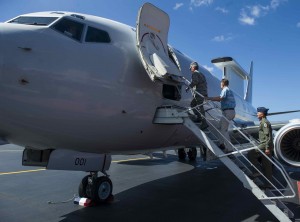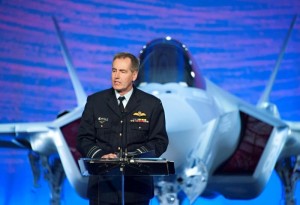2014-08-28 The Royal Australian Air Force or RAAF is in the throes of modernization.
It started with the C-17, next moved to the Wedgetail, then to the KC-30A and will see the F-35 become its core air fighter asset.
But RAAF modernization is not about air power; it is about agile, sustainable combat reach able to influence events in the region and beyond.

It is about an enhanced capability as well to work with various coalition partners, in the region and beyond.
The F-35 is a centerpiece in the modernization effort, but not as an in and of itself capability but as a leverage point for broader force structure modernization.
Air Marshal Brown has set in motion an effort to reshape the RAAF around its modernization efforts designed to become inextricably intertwined with the overall transformation of the Australian Defense Force.
Notably, Australia has made its basic air platform modernization decisions for the period ahead. This means that for defense industry working with Australia it is not about selling the next platform; it is about the ability to connect and enable the force.
This is how the COS of the RAAF put it in a presentation on May 29, 2014:
- I intend to release Plan Jericho, the RAAF transformation plan, in early 2015. It will guide our force transformation, enabled by our new 5th Gen capabilities, over the next decade.
- I will also be engaging closely with industry in the development of the plan.
- It is the technology that is being developed by industry that affords us the opportunity to transform our force. It is essential that we partner with industry to explore how we can maximize the opportunity offered by 5th Gen systems. I ask you to consider how you can work with us, not just at the platform level … but in helping us think through and design our overall future force using the 5th Gen capabilities you develop and will help us sustain in the future.”
In other words, industry working with the Australian MOD is expected to shift its approach from selling the next platform to shaping capability enhancers.
This will be a challenge both for the government and industry.
Even more recently (August 19, 2014), the COS provided an overview on the evolution of airpower which provided some thought leadership about the relationship of the evolution of forces and capabilities with 21st century strategic challenges.
The full speech can be found on our partner the RAAF Air Power Development Centre’s website, but some core excerpts follow which outline the thinking and the approach of the RAAF leadership.
Sometimes when one uses the term leadership one is simply referring to people sitting in a particular chair at the top of a hierarchy; other times like in this case, leadership refers to just that, leading.
Airpower and Rapid Force Insertion
If one factor has characterized the application of military force in this century it has been the very abbreviated lead times for the response by our forces and those of our allies.
That has been the case whether our government has requested that we rapidly deliver humanitarian aid in the wake of natural disasters or intervene in conflicts in our region or further afield.
Air Power is the most agile and most responsive military instrument available to Government regardless of the nature of the operation. Our leads times are calibrated in hours-even minutes- as events over Iraq in recent days demonstrated…
The Changing Strategic Calculus
It is no exaggeration to recognize that the status quo, which emerged after 1945, is now under enormous strain and fraying at the edges.
Whether in the perennially troubled Middle East or hitherto stable regions of Europe, numerous contemporary conflicts are becoming even more violent and intractable. Moreover, the threat of inter-state war in Europe and North Asia cannot be ruled out. Of particular concern to Australia is the rising tension in the South China Sea where are vital interests are directly engaged….
As the barbaric events in Ukraine last month demonstrated, a viable global order is still evolving in the wake of the fall of the Soviet Empire and many analysts fear the Russian back-lash against loss of its empire is just beginning.
It is quite poignant, as we mark the Centenary of the outbreak of the Great War in 1914, to recognize that so many conflicts, which arose in the power vacuum of the fall of the Russian, Ottoman or Austro-Hungarian empires continue in more virulent form today. Events in Syria, Iraq, Gaza and the Ukraine all had their origins in the aftermath of 1918. ….
Every significant security issue in North Asia is derived from interstate tension over borders and resources. Of course, all of these are made more complex by historical grievances and mistrust, as well as non –traditional issues such as climate change, increasingly frequent extreme weather events, and water and food scarcity. As I will explain air power must evolve -and is evolving – to provide Government with a full suite of options for securing Australia’s interests in this dynamic era.
According to the respected military theorist-Azar Gat-the rise of China, in concert with the renewed assertiveness of Russia, will constitute the defining trends, to which the United States and its key allies will be obliged to respond in the next decade. Gat makes the important point that the era of irregular war and counter-insurgency does not necessarily constitute a fundamental change in the nature of conflict.
Of more importance, he asserts, will be the return to the international system of totalitarian capitalist powers for the first time since the 1930s. This is an important insight. ….
The Central Role of Airpower as a Force Enabler
As events in Afghanistan in 2001-2, and more recently in Libya have revealed, it is possible to provide Government with a wider range of options, through the speed, reach and precision of air power in support of local ground forces. This reduces both our own costs and the political risk to our policy makers.
It is important for airmen to dispel some myths about air power, which have been allowed to proliferate since the1999 Kosovo campaign.
I do not believe that either our Government or our people have much enthusiasm for long- term nation building operations away from our immediate region. And if one accepts that premise, air power provides our Government with multiple options for exerting coercive influence, or delivering precise blows or merely putting an adversary at risk in order to influence his behavior; then it is obvious that air power must take its place at the center of our national security strategy…..
There is a dangerous myth afoot that the emergence of the insurgencies in Iraq and Afghanistan constituted a failure of air power, as the swift decisive results of 1991 were not replicated. Such analysis ignores the vital contribution of air power right across the spectrum even in irregular wars.
In addition to close air support, which has inflicted massive casualties on our insurgent enemies, air power has been indispensable to the deployment and sustainment of our forces through replenishment and casualty evacuation.
And the use of air and space ISR capabilities to dominate the electronic and cyber domains has conferred an extraordinary asymmetric advantage on our land-forces. It would not be appropriate to canvass the full suite of effects that air power has generated across all domains in Iraq and Afghanistan but it has been integral to our operational effectiveness….
The Transformation of the RAAF and the ADF
We are seeking to become more agile, to extend our reach, to hit harder and more precisely and to see further and more quickly and to disseminate this common operational picture throughout the joint force. Every platform that we are introducing – whether airborne early warning aircraft or airborne refuelling aircraft – contributes to the achievement of those concerted effects.
Of course the most high profile element of our modernization plan is the introduction of 5th generation fighter aircraft in the form of the F35. As the most visible symbol of Air Force modernization I welcome public interest in the F35, or JSF as it is colloquially known.

However, as formidable and transformative as the F35 is, I do not want it to become a distraction from the holistic and coherent nature our strategic modernization.
The JSF will exponentially enhance our air combat and strike capability, but its truly transformative impact on the ADF will depend on its ability to truly operate within a system of systems. My intention for transformation is that the F35 and other capabilities within the force will be employed in a way that maximizes our effectiveness. ….
The F35 will be simply the ‘smartest’ and most agile aircraft ever to fly. It will provide us with a winning edge well into the future. And it brings versatility across numerous air power roles, performing them simultaneously. It can deliver precision strike while sweeping up copious amounts of information.
Indeed, one of the real challenges we will face across the ADF is to ensure that we adapt our joint systems to maximize the effects that the F35 can deliver by ‘joining up’ the joint maritime force, through providing kinetic strike and ISR options from theatre level, right down to an individual soldier on the ground.
In conjunction with the Air Warfare Destroyers, the EA-18G Growler, our future Maritime Surveillance platforms and other force elements, our joint forces will be postured to achieve our maritime strategy in defense of Australia and its interests in our near approaches and further afield. Getting our joint doctrine and our recruitment and training systems balanced to ensure that we can fully exploit this technology will be one of our most significant challenges. And of course space power will enable and enhance the entire system…..
Airmen enlisting next year may retire in the 2050s. The problems that they will be required to solve are beyond our imagination, just as the systems they will operate may not even yet exist. Recruiting, training, educating and retaining the exceptional men and women that we will need to maintain our winning edge is actually one of our major institutional risks over time. That is why we have moved to implement measures to make us an employer of first choice. That is why we seek to expand and diversify our sources of recruits. We cannot waste a single motivated man or woman.
For our Special Report on Australian Defense Modernization see the following:


